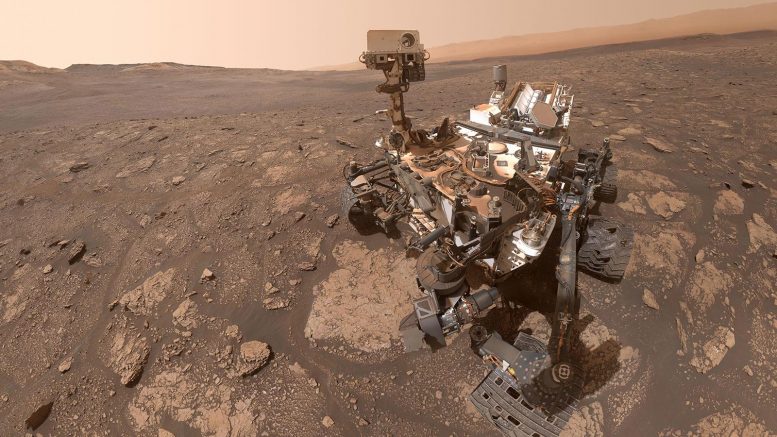Research suggests that atmospheric pressure changes on Mars may release underground methane into the atmosphere, aiding the Curiosity rover in its quest for life signs. (Artist’s concept.) Credit: SciTechDaily.com
Simulations will help Curiosity search for signs of past or present life on the Red Planet.
New research shows that atmospheric pressure fluctuations that pull gases up from underground could be responsible for releasing subsurface methane into Mars’ atmosphere; knowing when and where to look for methane can help the Curiosity rover search for signs of life.
“Understanding Mars’ methane variations has been highlighted by NASA’s Curiosity team as the next key step towards figuring out where it comes from,” said John Ortiz, a graduate student at Los Alamos National Laboratory who led the research team. “There are several challenges associated with meeting that goal, and a big one is knowing what time of a given sol (Martian day) is best for Curiosity to perform an atmospheric sampling experiment.”
The paper was published in January 22 in the Journal of Geophysical Research: Planets.

New simulations are helping inform the Curiosity rover’s ongoing sampling campaign. Credit: NASA/JPL-Caltech/MSSS
A primary focus of NASA’s Mars missions, including Curiosity and Perseverance, is to detect and understand past or present signs of life, such as methane. However, with the source of methane on Mars likely being underground, short-term variations in atmospheric methane levels have posed a research challenge.
To better understand Mars’ methane levels, Ortiz and his team used high-performance computing clusters to simulate how methane travels through networks of underground fractures and is released into the atmosphere, where it then mixes within the atmospheric column. They also modeled how methane is adsorbed onto the pores of rocks, which is a temperature-dependent process that may contribute to the methane level fluctuations.
Their simulations predicted methane pulses from the ground surface into the atmosphere just before the Martian sunrise in the planet’s northern summer season, which just recently ended. This corroborates previous rover data suggesting that methane levels fluctuated not only seasonally, but also daily.
This valuable data is helping inform the Curiosity rover’s ongoing sampling campaign.
“Our work suggests several key time windows for Curiosity to collect data. We think these offer the best chance of constraining the timing of methane fluctuations, and (hopefully) down the line bringing us closer to understanding where it comes from on Mars,” Ortiz said.
Reference: “Sub-Diurnal Methane Variations on Mars Driven by Barometric Pumping and Planetary Boundary Layer Evolution” by J. P. Ortiz, H. Rajaram, P. H. Stauffer, K. W. Lewis, R. C. Wiens and D. R. Harp, 22 January 2024, Journal of Geophysical Research: Planets.
DOI: 10.1029/2023JE008043
This research was supported by a Student Fellowship grant through the Center for Space and Earth Science, which is funded by the Laboratory Directed Research and Development program under project number 20210528CR.





